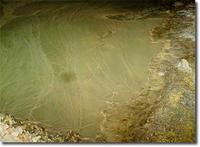
Acidophilic microbes thrive in this biofilm growing inside an abandoned mine at Iron Mountain, Calif. The microbes' metabolism creates highly toxic acid mine drainage, a major environmental problem associated with the mining of coal and uranium. When humans gather in communities, they specialize and adapt. Farmers grow crops and raise animals for food based on the area's climate and soil. Builders fashion structures engineered to keep their inhabitants warm in winter and cool in summer. Physicians tend to the sick; police and firefighters protect the public.
Communities of microorganisms, researchers are finding, exhibit very similar behavior – genetically evolving, specializing and cooperating in ways that allow them to adapt to extreme conditions of temperature, acidity, toxicity and pressure.
In the first comprehensive study of gene expression in a microbial community from an "extreme" natural environment, scientists from Lawrence Livermore and Oak Ridge national laboratories, the University of California, Berkeley, and Xavier University in New Orleans have identified more than 2,000 proteins produced by five key species in the community. More than 500 of the proteins – chains of amino acids linked together in an order specified by a gene's DNA sequence – appear to be unique to the community, which thrives in hot, highly acidic conditions in an Environmental Protection Agency Superfund site at an abandoned mine at Iron Mountain, Calif. A report on the research, "Community proteomics of a natural microbial biofilm," appears online today in Science Express.
"This is the first effort to accumulate information on genes that are expressed within a natural community, and one that has a major environmental impact," said Michael Thelen, a protein biochemist at Lawrence Livermore. "One of the most interesting things we found is that there are large numbers of proteins that don't resemble any other proteins we know about. Many are enzymes that function to maintain the correct structure of other proteins that are exposed to the unusually harsh acidic environment."
The Iron Mountain microbial community, which consists of bacteria and archaea, has been under study for nine years by a research team lead by Jill Banfield, professor of earth and planetary science and of environmental science, policy and management at UC Berkeley. Last year it became the first microbial community characterized at the genetic level through large-scale genome sequencing at the DOE Joint Genome Institute in Walnut Creek, Calif.
"This work illustrates the power of the genome sequencing done at the Department of Energy's Joint Genome Institute to contribute to understanding the microbiological communities living at contaminated sites," said Dr. Raymond L. Orbach, Director of DOE's Office of Science. "Now scientists can investigate not only the 'community genome,' but also the resulting 'community proteome' for enzymes and pathways that can help clean up some of the worst environmental sites in the nation. This underscores the value of basic research carried out by the DOE Genomics:GTL Program that can develop novel approaches and solutions to national challenges."
The microorganisms, known as "extremophiles" for their affinity to harsh environments, grow as a biofilm at the Richmond Mine near Redding in Northern California. The complex interaction of microbes, water and exposed ore at the mine has generated dangerously high levels of sulfuric acid and toxic heavy metals, known as acid mine drainage.
The microbes are densely packed in the pink biofilm, which is just a few millimeters thick and floats on the surface of the mine water. The biofilm is a self-sustaining system, using carbon and nitrogen from the atmosphere within the mine and deriving energy from iron that has been leached out of the iron sulfide rock, also known as pyrite or "fool's gold."
The researchers used an analytical technique called mass spectrometry to identify the proteins present in the biofilm, then correlated them with genes from each of the major organisms identified in the earlier genomic study. They found that many community functions, such as nitrogen fixation, are handled by specialized microbes.
"We found a cytochrome protein made in abundance by one bacterial member of the community, Leptospirillum Group II, that's a key factor connecting the biology with the environmental surroundings – it's likely the first step in iron oxidation through an electron capture by the cytochrome," Thelen said. "We also found that a different bacterium, Leptospirillum Group III, apparently makes more of the polysaccharide that is needed as a matrix or housing material for the biofilm community."
Thelen said researchers still have much to learn about the molecular mechanisms involved in assembling microbial communities, the partitioning of metabolic tasks within the communities, and how carbon, nitrogen and energy resources are allocated into metabolic pathways. The information could ultimately be useful for understanding the functioning of biofilms in a variety of environments, including some with implications for human health.
"These organisms have evolved to adapt to their specific environment," Thelen said, "and as they invent new methods for doing this, they come up with genes that are different enough from other organisms to enable them to survive in that particular niche. We just have started to find how many of these genes are not understood. It's just now coming to light how much of the genome is still a mystery."
Source : DOE/Lawrence Livermore National Laboratory
 Print Article
Print Article Mail to a Friend
Mail to a Friend
